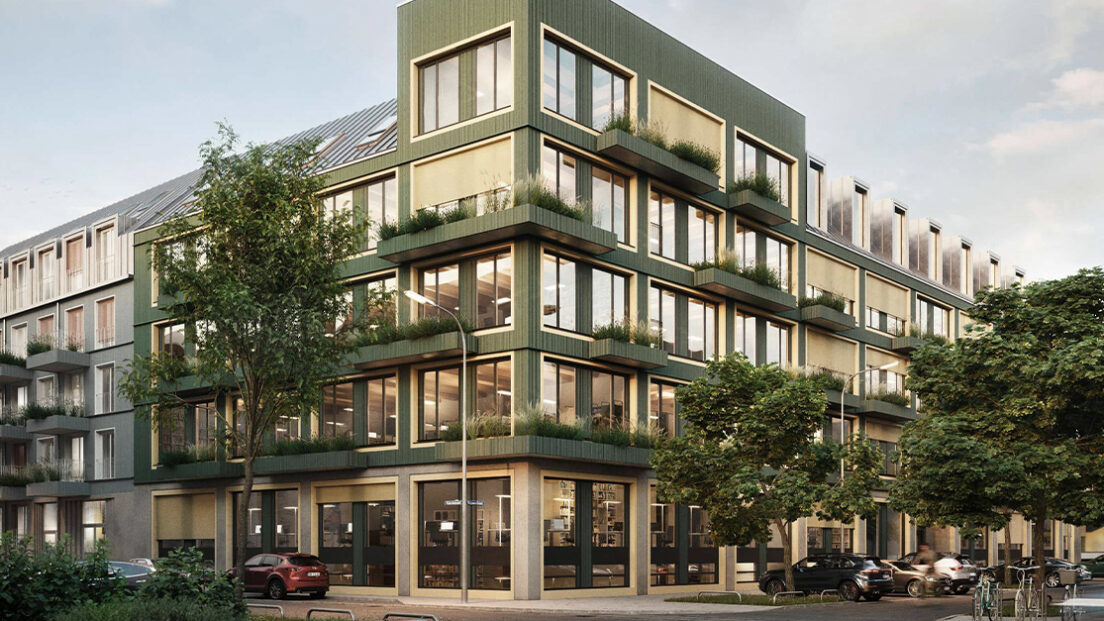Hybrid buildings made of wood have a future

Colorfully designed wooden facades with a special greening concept will soon characterize Munich's St. Vinzenz district. Because on the corner of Gabrielenstraße 3 and Rupprechtstraße 22, the project developer Bauwerk is building the wood hybrid ensemble VINZENT for living and office. It is the first of its kind in Munich's inner city structure and is thus a pioneer for inner-city, sustainable new buildings for living and working. The architect and urban planner Ludwig Wappner from the lead office allmannwappner explains in an interview why wood was forgotten as a building material for a long time, what accounts for the current boom and what innovative thoughts and visions are behind VINZENT.
Mr. Wappner, wood is one of the oldest building materials in Central Europe. We all know stilt houses or medieval half-timbered houses. Nowadays, however, wooden buildings are rare. Since when has wood been forgotten, especially in the urban context of construction, and why?
It is correct: the building material wood was used much more frequently for the construction of buildings in the past. This is mainly due to the fact that wood has always been available in sufficient quantities in our Central European regions – also because the climatic conditions in Germany and many other European countries favor rapid regrowth. Due to the enormous effort in building in the past centuries, craftsmen over many generations have developed excellent knowledge and skills to deal with this material in an increasingly creative, skilful and efficient way. We still benefit from that today.
Especially in the urban context, however, wood fell into oblivion in the course of industrialization from the middle of the 19th century or received industrially manufactured competition as a building material. Machine-made building materials such as brick or concrete were increasingly preferred. Because they could be produced cheaper, faster and in large quantities. In addition, many of our cities used to be built entirely of wood and have burned down several times in their history. Wood was therefore anchored in people’s minds as a source of danger. Structural fire protection in connection with dense inner-city development has always been an issue in urban planning. In contrast, in the industrial age, more fire-resistant building materials provided better safety evidence and thus more trust among people. This is one of the reasons why industrial building materials have increasingly replaced wood, especially in European urban planning.
How do you explain the current boom in timber construction?
The timber construction boom was clearly triggered by the growing ecological awareness in society. Wood is so attractive as a building material because we work with a renewable, resource-saving and circular raw material. With wood we can store CO 2 in buildings and thus counteract the energy-intensive production of other building materials and their use with a sustainable and environmentally friendly statement. The CO 2 balance of wood is unbeatably good compared to other building materials. But wood is not infinitely available, so we have to use the resources wisely.
The current boom is also made possible by extensive research in recent years – especially in regions such as Vorarlberg, Graubünden or South Tyrol, but also in the Black Forest and the Allgäu. Today we have a great deal of knowledge about the material, which is paired with the centuries-old handed-down craftsmanship experience. There are now excellent opportunities to optimally test the load-bearing capacity and fire resistance of wood in long-term tests.
Digitization plays another major role. CNC technology and other technical revolutions were a real quantum leap here. Thanks to the technically based use of machines, wood can now be processed and pre-produced down to the millimeter. This then happens directly in a workshop, where the components can be prefabricated in the dry and some can already be assembled. This high degree of prefabrication of modular wooden elements saves a lot of time and money.
As a result of all these developments, wood as a building material has become very exciting again in recent years – and trust in the material has grown enormously. In addition, wood also has many other advantages that people appreciate: it smells good, looks familiar and feels pleasant.